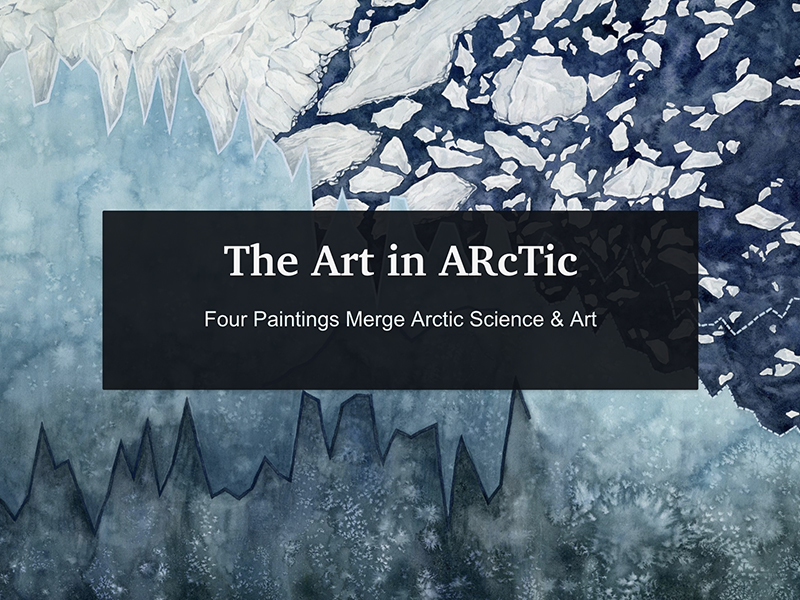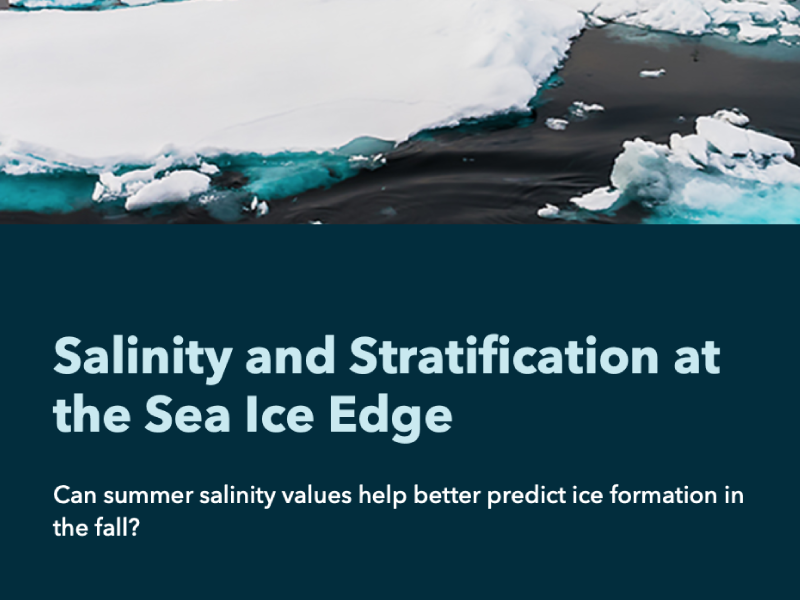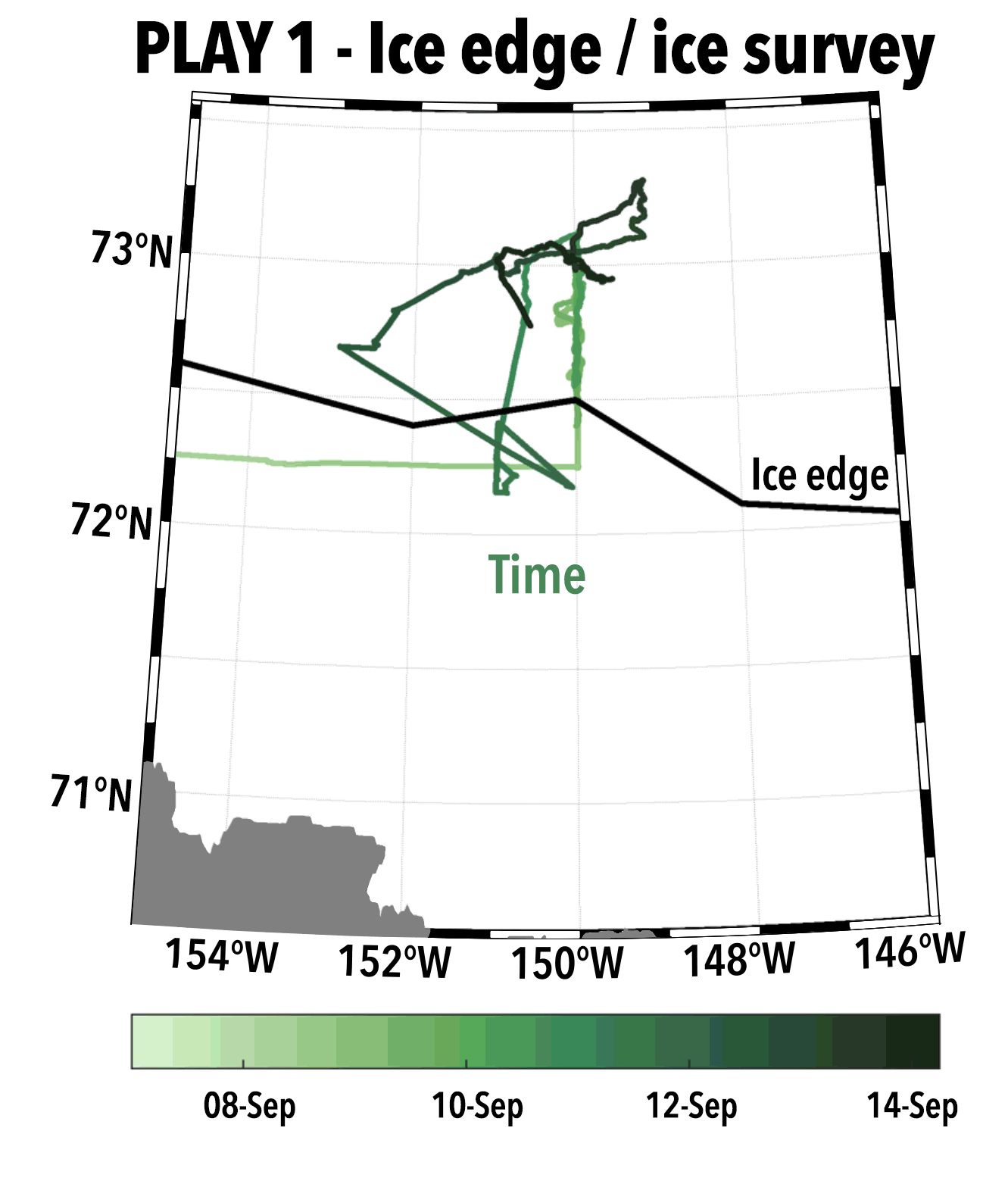Sea ice extent in the Arctic Ocean has declined dramatically over the past decades. Autumn ice advance is slower and occurs later, while summer ice retreat is faster and occurs earlier. The result is a lengthening open-water period each year, leading to changes in air-sea heat and momentum fluxes, the freshwater cycle, surface albedo feedbacks, primary production, and regional and global climate as well as human and ecological health.
Our experiment examines how summer ice melt evolves into and is inexorably linked with autumn sea ice advance. A major SASSIE milestone was completed in September 2022: a monthlong scientific cruise in the Beaufort Sea aboard the R/V Woldstad.
Overview of SASSIEHow did the cruise "play out"? During the Cruise Planning meeting, the SASSIE team drew up a series of "plays" that would be chosen based on sea ice, ocean, and weather conditions. They executed a total of five plays during the cruise:
PLAY 1: Ice edge / ice survey – Bad weather prevented the ship from going into open water, so the team carried out a survey through the sea ice; Strong salinity and temperature gradients were observed near the ice edge [Sep. 8-14]
PLAY 2: Zig-zag open water survey – The ship emerged from the sea ice and headed east to map the open water south of the ice edge; Each southeast tack ("zig") entered warmer water while each northeast ("zag") entered colder water [Sep. 14-16]
PLAY 3: Ice survey – Typhoon Merbok hit the Bering Strait so the ship headed northeast into the sea ice to avoid the rough seas; The team surveyed around several drifters and assets within the sea ice [Sep. 16-18]
PLAY 4: Drifter-following survey – Drifters were deployed on both sides of a strong salinity gradient; The ship then carried out four survey "boxes" around these assets as they drifted northwest, collecting continous underway CTD measurements to capture the upper ocean structure including during low-wind conditions when significant stratification was present [Sep. 19-24]
PLAY 5: Repeated ice-open water survey – The ship made 14 transects from open water to sea ice across a 1 psu salinity gradient to capture the evolution of the upper ocean during the approach to freeze-up; Strong surface signals were observed at the north end of the line and an eddy was observed in the south [Sep. 24-28]
What Types of Tools Were Used in Each Play? ["SASSIE Tools" page]

|

|

|

|
|
| PLAY #1 | Recovered, charged & redeployed Wave Gilders (WG); Conducted JetSSP surveys; PALS first flight | uCTD survey (& CTD casts in ice) along 150°W | Deployed Under Ice Float, ALAMO, and 4 ALTOs | Deployed & recovered a line of SWIFTs; Deployed SVP-S2, 2 UpTempOs, and 2 Ice Mass Balance buoys (IMBs) in ice |
| PLAY #2 | PALS flight above ship's zig-zag pattern | Continuous uCTD (& several CTD casts in heavy seas or ice) | ALAMO float deployed at furthest east point of survey | SVP drifter deployed at furthest east point of survey |
| PLAY #3 | JetSSP survey beside SWIFTs; PALS survey flights continued | CTD casts in ice | SVP-S and IMB deployed in moderate ice cover; Two SWIFTs deployed & recovered | |
| PLAY #4 | WGs recovered, recharged & redeployed two WGs; JetSSP deployments | Continous uCTD around drifters | ALAMO deployed at south end of survey area | SVP-S, SWIFTs, and UpTempO deployed; SWIFTs recovered |
| PLAY #5 | Recovered, recharged & redeployed 2 WGs; JetSSP deployments; All WGs recovered | Continuous uCTD | ALAMO deployed | Two SVP-S drifters and 3 SWIFTs deployed; All SWIFTs recovered; IMB deployed in water |
How are we testing our hypothesis?
Analyzing data from the September 2022 cruise:
The primary aim of the field campaign was to capture the upper ocean structure during the transition from summer sea ice retreat to autumn sea ice advance. We are quantifying the strength, size, and depth of fresh near-surface anomalies resulting from melting ice; the horizontal and vertical structure of those fresh anomalies as they evolve due to air-sea fluxes and waves, ocean currents and mixing; and the ocean conditions and the presence of sea ice as it begins to form.
| 2022 Field Campaign Overview | |||
|---|---|---|---|
| August | September: Intensive Observing Period (IOP) | October and Beyond | |
| Platforms | Small vessels deployed instruments ahead of the IOP | Large vessel (Woldstad), Unmanned Aerial Systems, Aircraft with salinity and other sensors | Some instruments will remain behind to measure freeze-up conditions |
| Key instruments [tools page] |
Autonomous Assets – Wave Gliders, Ice Mass Balance buoys |
Ship – Underway CTD, Salinity Snake, Air-sea flux sensors
Piloted and Drifting Assets – Wave Gliders, SWIFT, UIF, Surface Velocity Program Drifters, UpTempO buoys, Jet Surface Salinity Profiler
|
UpTempO buoys, UIF, SWIFT and Surface Velocity Program Drifters |
| Satellite & other data |
Salinity – Soil Moisture Active Passive (SMAP), Soil Moisture Ocean Salinity (SMOS)
Temperature – NOAA Optimum Interpolation Sea Surface Temperature (OISST)
Sea Ice Properties, Motion, and Melt – National Snow and Ice Data Center, ICESat-2, Synthetic Aperture Radar
Air-sea Fluxes – NASA Modern-Era Retrospective analysis for Research and Applications (MERRA), European Centre for Medium-Range Weather Forecast (ECMWF), and others
|
||


